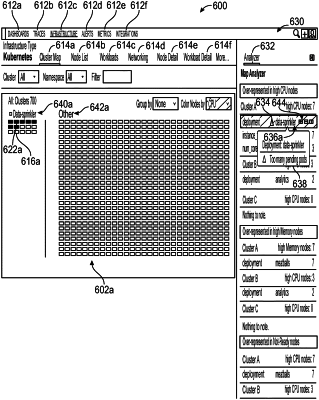| CPC G06F 16/287 (2019.01) [G06F 3/0482 (2013.01); G06F 3/0484 (2013.01)] | 20 Claims |

|
1. A computer-implemented method for navigating clusters of a data structure, the method comprising:
gathering data from the data structure by instrumenting instances of application software executing on the data structure, the gathered data comprising metadata generated by the instrumented software;
identifying clusters of the data structure based on the gathered data;
causing display of a cluster map of the data structure, the cluster map comprising a plurality of clusters, each cluster of the plurality of clusters comprising a plurality of nodes, each node of the plurality of nodes comprising a plurality of pods, each pod of the plurality of pods comprising a plurality of containers;
providing a status for each node, each pod, and each container of each cluster, the status comprising an outline around each cluster, wherein the outline is based on a color code comprising at least a first color for indicating good health, a second color for indicating moderate health, and a third color for indicating bad health;
causing display of analysis of each cluster of the cluster map, the analysis comprising granular information for each cluster;
isolating an item of interest based on filtering the clusters by comparing nodes running a deployment to nodes not running the deployment, the item of interest comprising a deployment having a potential source of errors, the potential source of errors comprising at least one of over-represented CPU nodes, over-represented memory nodes, and/or over-represented not-ready nodes;
diagnosing the item of interest, wherein diagnosis is based on a container-to-service correlation; and
causing display of the item of interest comprising the deployment as an interactive link, wherein additional information is provided upon interacting with the interactive link, the additional information relating to at least an alert for the deployment.
|